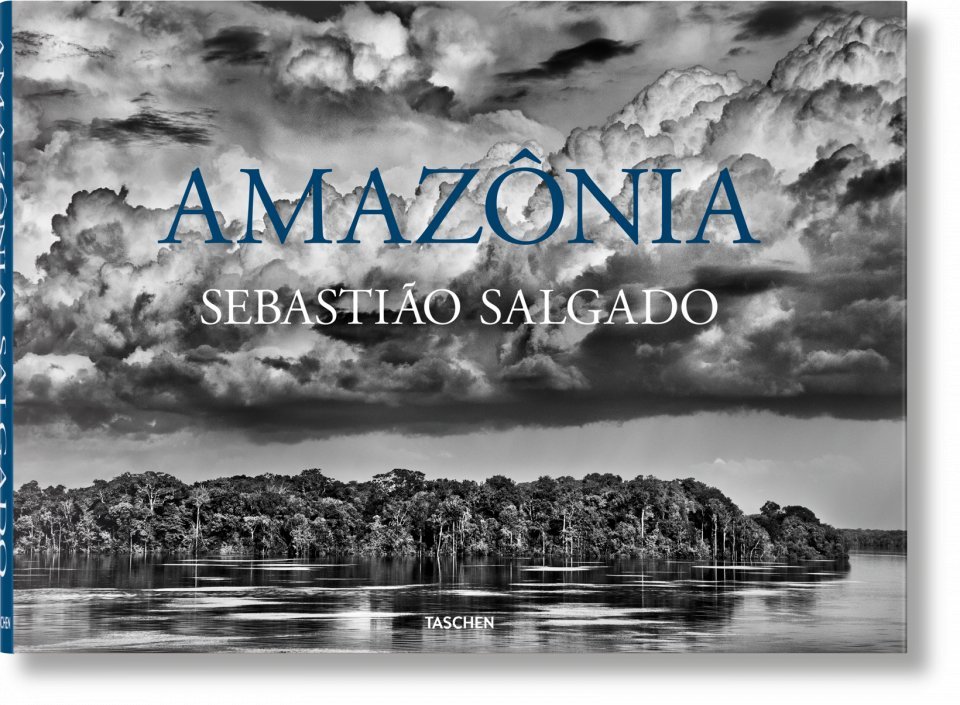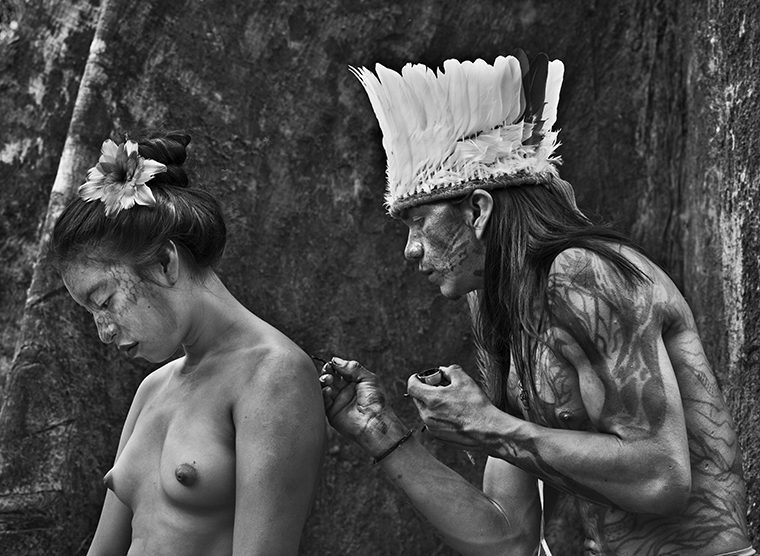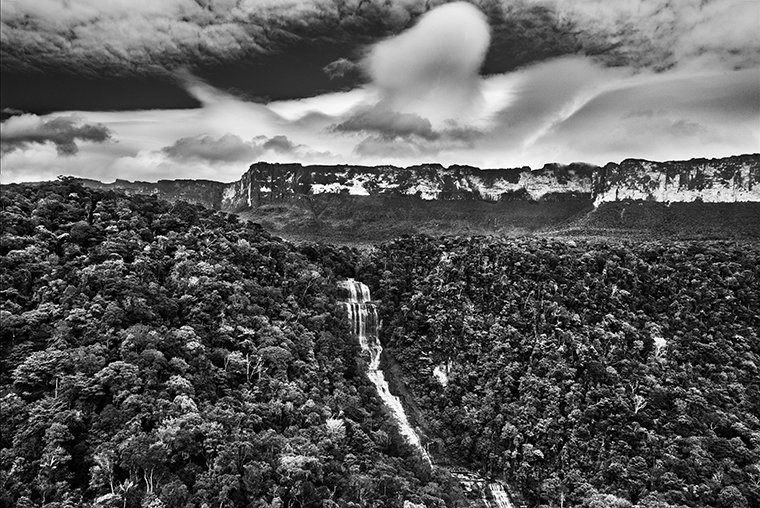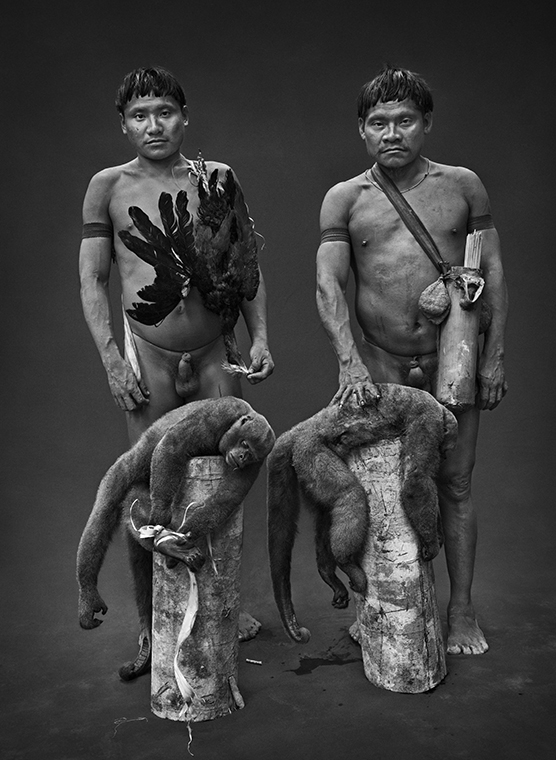Sebastião Salgado
AMAZÔNIA

Marauiá mountain range. Yanomami Indigenous Territory. Municipality of São Gabriel da Cachoeira, state of Amazonas, 2018. © Sebastião SALGADO Published by TASCHEN.
Published by TASCHEN
Hardcover, 35.8 x 26 cm, 528 pages
Sebastião Salgado traveled the Brazilian Amazon and photographed the unparalleled beauty of this extraordinary region for six years: the forest, the rivers, the mountains, the people who live there—an irreplaceable treasure of humanity.
In the book’s foreword Salgado writes: “For me, it is the last frontier, a mysterious universe of its own, where the immense power of nature can be felt as nowhere else on earth. Here is a forest stretching to infinity that contains one-tenth of all living plant and animal species, the world’s largest single natural laboratory.”
Salgado visited a dozen indigenous tribes that exist in small communities scattered across the largest tropical rainforest in the world. He documented the daily life of the Yanomami, the Asháninka, the Yawanawá, the Suruwahá, the Zo’é, the Kuikuro, the Waurá, the Kamayurá, the Korubo, the Marubo, the Awá, and the Macuxi—their warm family bonds, their hunting and fishing, the manner in which they prepare and share meals, their marvelous talent for painting their faces and bodies, the significance of their shamans, and their dances and rituals.
Sebastião Salgado has dedicated this book to the indigenous peoples of Brazil’s Amazon region: “My wish, with all my heart, with all my energy, with all the passion I possess, is that in 50 years’ time this book will not resemble a record of a lost world. Amazônia must live on.”
“This book is dedicated to the indigenous peoples of Brazil’s Amazon region. It is a celebration of the survival of their cultures, customs, and languages. It is also a tribute to their role as the guardians of the beauty, natural resources, and biodiversity of the planet’s largest rainforest in the face of unrelenting assault by the outside world. We are eternally grateful to them for allowing us to share their lives.” — Sebastião Salgado and Lélia Wanick Salgado
BOOK CLUB LIVE: SEBASTIÃO SALGADO IN CONVERSATION WITH PETER FETTERMAN
Tuesday, June 22
5 pm BST | 6pm CET | 12 pm ET | 9 am PT
Free, registration required.
As part of the Book Club live events, Photo London is delighted to present Brazilian social documentary photographer and photojournalist Sebastião Salgado in conversation with gallerist Peter Fetterman.
One of the most recognised photographers working today, Salgado is primarily known for his long-term social documentary projects, having travelled to over 120 countries to shoot his projects.
He has completed a photographic project about Brazil’s Amazon forest and its inhabitants, the indigenous communities; it aims to raise awareness of the threats they face from illegal logging, gold mining, dam building, cattle and soybean farming and, increasingly, from climate change. This project will be presented to the public this year in the form of exhibitions and a monographic book titled AMAZÔNIA (Taschen, 2021).
In this exclusive conversation, Salgado will present AMAZÔNIA in conversation with his long time gallerist and photography expert Peter Fetterman, whose eponymous gallery in Santa Monica holds one of the USA’s most extensive inventories of classic 20th Century photography, particularly humanist photography.
Sebastião Salgado, born in 1944 in Minas Gerais, Brazil, lives in Paris, France. He is married to Lélia Wanick Salgado. They have two sons and two grandchildren.
Having studied economics, Salgado began his career as a professional photographer in 1973 in Paris, working with photo agencies among which Magnum Photos until 1994, when he and Lélia Wanick Salgado founded Amazonas images, formed exclusively for his work. Today this structure is their studio. He travelled in over 100 countries for his photographic projects. Beyond press publications his work was presented in books such as Other Americas, 1986. Sahel: l’homme en détresse, 1986. Sahel: el fin del camino, 1988. Workers, 1993. Terra, 1997. Migrations and Portraits, 2000. Africa, 2007. Genesis, 2013. The Scent of a Dream, 2015. Kuwait, a desert on fire, 2016 and Gold, Serra Pelada Gold Mine, 2019. All these books have been edited, conceived and designed by Lélia Wanick Salgado. Touring exhibitions of these works have been, and continue to be, presented in museums and galleries throughout the world. A majority of these have been curated by Lélia Wanick Salgado.
In 2013 came out the book De ma terre à la Terre (From my land to the planet), a narrative account of Salgado’s life and career, written by French journalist Isabelle Francq. In 2014, came out the documentary film The Salt of the earth, co-directed by Wim Wenders and Juliano Ribeiro Salgado. Selected for major film festivals, it won the Special Prize at the 2014 Cannes Film Festival in the ‘’Certain Regard’’ section, as well as France’s César Award for Best Documentary Film in 2015, and a nomination for the Academy Award for Best Documentary at the 87th Academy Awards. Salgado has completed a photographic project about Brazil’s Amazon forest and its inhabitants, the indigenous communities; it aims to raise awareness of the threats they face from illegal logging, gold mining, dam building, cattle and soybean farming and, increasingly, from climate change. This work is scheduled to be presented to the public in 2021, in the form of books and exhibitions, titled AMAZÔNIA.
Sebastião Salgado is a UNICEF Goodwill Ambassador, and among other distinctions, he was named an honorary member of the Academy of Arts and Sciences in the USA. He received numerous photographic prizes and prestigious honors, such as the Grand Prix National, Ministry of Culture, France ; the Príncipe de Asturias Award for Arts, Spain ; the Medal of Presidenza della Repubblica Italiana, International, Research Center Pio Manzù, Italy. He was named Comendador da Ordem do Rio Branco in Brazil, and Commandeur de l’Ordre des Arts et des Lettres, Ministry of Culture in France. In 2016, Salgado was elected member of the Académie des Beaux-Arts of Institut de France, and the same year, France named him Chevalier (Knight) de la Légion d’Honneur. In 2018, he was made Chevalier de l’Ordre du Mérite Culturel by the Principality of Monaco. In 2019, he was elected Foreign Honorary Member of the American Academy of Arts and Letters, New York, USA and honored with the Peace Prize of the German Book Trade, Germany. In 2021, Salgado received the 27th Annual Crystal Award, the World Economic Forum/Davos. Since the 1990’s, Lélia and Sebastião have decided to go beyond recording the condition of the planet and become directly engaged themselves by reforesting a family property in the Brazilian state of Minas Gerais with the original species of the Atlantic forest. Like so many others farms in the region, the land had been cleared of trees to accommodate cattle but, decades later, was eroded and unproductive. Through the Instituto Terra, as the project is named, over the past 20 years, 2.5 million saplings of native species have been planted and 800 hectares restored. And in the process, not only have streams been revived, but long-absent insects, birds and animals have also returned. The Instituto is dedicated to a mission of reforestation, conservation and environmental education.
Born in London, Peter Fetterman has been deeply involved in the medium of photography for over 40 years. Initially a filmmaker and collector, he set up his first gallery over 30 years ago in 1988. He was one of the pioneer tenants of Bergamot Station, the Santa Monica Center of the Arts when it first opened in 1994.
The gallery has one of the largest inventories of classic 20th Century photography in the country particularly in humanist photography. Diverse holdings include work by Henri Cartier-Bresson, Sebastião Salgado, Steve McCurry, Ansel Adams, Paul Caponigro, Willy Ronis, André Kertesz, Manuel Alvarez Bravo, Lillian Bassman, Pentti Sammallahti, Sarah Moon and Jeffrey Conley.
Peter and his colleagues are committed to promoting the awareness and appreciation of the most powerful of the mediums in an intimate, user-friendly salon environment.

Sebastião Salgado, ‘AMAZÔNIA’, TASCHEN, 2021.

Keiá Yawanawá from the village of Mutum, paints the back of young Kanamashi, from the village of Amparo. The flower-shaped ornament in her hair is made of bird feathers. Rio Gregório Yawanawá Indigenous Territory, state of Acre, 2016. © Sebastião SALGADO.

The Raposa–Serra do Sol Indigenous Territory occupies two ecologically distinct areas: fields in the south and densely forested mountains in the north. Its main landmark is Mount Roraima, seen in the background, whose name is associated with the mythological hero Makunaima. This hero inspired Brazilian author Mario de Andrade’s classic novel Macunaíma. There are an estimated 140 Macuxi villages. Cotingo River Falls. State of Roraima, 2018. © Sebastião SALGADO

Left to right: Pinu Vakwë Korubo with a bird, a red-throated piping- guan (Aburria cujubi, Korubo name: kuxu) hanging from his shoulder— contact in 2014; Xuxu Korubo with a quiver for arrows (Korubo term: vitinte) on his shoulder—contact in 2015. In front of them, two brown woolly monkeys (Lagothrix lagothricha, Korubo term: kolokit) brought down by poisoned arrows from Xuxu’s quiver, shot from blowguns. Hunting encampment. Valley of Javari Indigenous Territory, state of Amazonas, 2017. © Sebastião SALGADO
